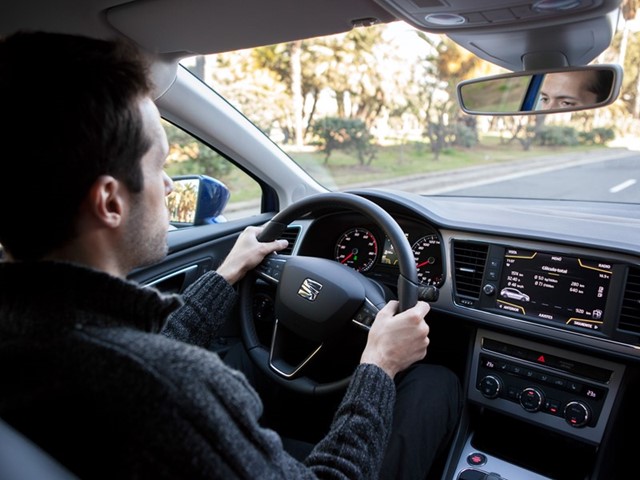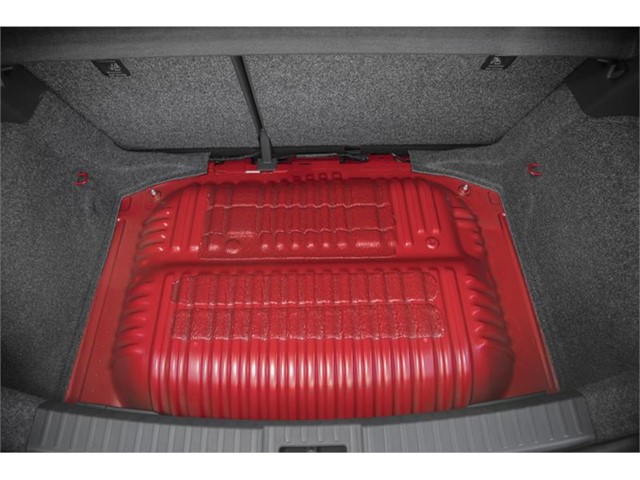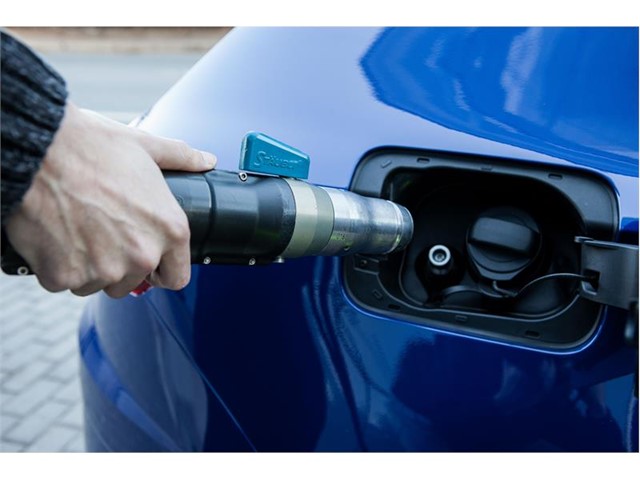At the wheel of a car fuelled with CNG
They are more economical and just as safe and powerful; the expert on CNG at SEAT debunks some of the misconceptions about these vehicles. These models can be driven up to 1,300 kilometres without having to refuel thanks to their dual gas and petrol tanks. As they are sustainable, they are allowed to drive during traffic restrictions imposed by pollution levels.
They are cheaper to run and equally safe and powerful as cars fuelled with petrol or diesel. Either through lack of awareness or due to their novelty, there are several myths surrounding vehicles that run on compressed natural gas (CNG). The head of CNG Product at SEAT, Andrew Shepherd, dispels these false beliefs and explains how these sustainable vehicles work:
- The same feeling at the wheel? Yes. The idea that driving a CNG car is different from conventional vehicles is wrong. In fact, “the feeling while driving is exactly the same, as the performance of gas engines is identical to that of diesel or petrol engines with the same power output”, the expert affirms.
- Is a gas tank just as safe? “Absolutely yes. Gas tanks are designed, made and certified according to the highest industry standards”, Shepherd points out, adding that these gas tanks “are equipped with a safety valve, and in the unlikely event of a fire, would release the gas to the outside air in a controlled manner, preventing anything from happening to the vehicle”. In addition, the components have been tested to endure “extreme conditions: the tank reaches a maximum pressure of about 200 bars, but it is designed to withstand more than twice as much”. Furthermore, Shepherd highlights that the myth that gas can freeze under conditions of use is “impossible” because “in order for natural gas to liquefy, the outside temperature would have to be colder than 160 degrees below zero”.
- Can you drive when pollution levels are critical? Yes. These cars are classified with the ‘ECO’ label, so they can be driven when pollution levels restrict access to city centres. In addition, this distinction gives certain benefits to owners of these models, such as a tax reduction and incentives in some countries, including Spain, Italy or France.
- Can you keep driving when the gas runs out? Yes. When the gas in the tank is consumed, the car automatically switches over to petrol. “The driver can continue without having to stop, and an indicator is displayed on the instrument panel that the car is running on petrol”, explains Andrew Shepherd. In fact, the driving range without having to refuel thanks to this dual powered technology by SEAT is 1,300 kilometres, the distance between Barcelona and Frankfurt. Refuelling with gas is possible in European countries with a gas station network because “the system uses a universal nozzle”.
- Can I drive exclusively on gas? Yes. CNG vehicles run on gas by default and you can drive without ever having to switch over to the other tank. Despite this, you should always have a minimum amount of petrol when starting the engine in very cold temperatures or immediately after refuelling with natural gas. This amount of petrol should be consumed within about six months.
- Do they cost about the same as traditional vehicles? Yes. The sales price of these cars is similar to diesel and petrol cars, not to mention their long term benefits. In this sense, Andrew points out that “it only costs about 13 euros to fill the tank” so CNG cars “allow you to sabe 30% compared to diesel and 55% compared to petrol fuelled vehicles.”
- Do they require similar maintenance? Yes. The mechanical operation of gas vehicles is the same as traditional cars. “It’s false that spark plugs or filters have to be changed more often”, refutes the SEAT expert to counter the myths that suggest that CNG engines overheat and are more expensive to maintain. The only thing that differs is that “the tightness of the gas system must be certified prior to each MOT inspection, and the condition of the tanks has to be checked visually every four years at a specialist garage”. These revisions are proof of the highest safety standards surrounding cars fuelled with natural gas.
For Andrew Shepherd, there is every indication that this fuel will play a key role in future mobility, sales of SEAT’s CNG vehicles went up by 18% in Europe.

The feeling at the wheel of a car fuelled with compressed natural gas is identical to those powered by diesel or petrol



What is CNG?
Have you heard that CNG is better for the environment and your wallet? Learn why.
Basics
CNG is a readily available alternative to gasoline that’s made by compressing natural gas to less than 1% of its volume at standard atmospheric pressure. Consisting mostly of methane, CNG is odorless, colorless and tasteless. It’s drawn from domestically drilled natural gas wells or in conjunction with crude oil production.
Natural gas powers more than 12 million vehicles on the road today. Unfortunately, only about 250,000 of these are being used in the U.S., according to GE. The average growth rate in the U.S. shows a 3.7% increase per year since 2000, as contrasted with a booming global growth rate of 30.6% per year.
Expanding the numbers of CNG fueling stations would allow for the increase of CNG vehicles on U.S. roads. There are 12,000 around the world, yet the U.S. claims about 500 public stations. New technologies and greater demand mean that the number of new stations is climbing rapidly.
However, as gasoline prices continue to rise, American interest in CNG is rising, and with good reason – CNG costs about 50% less than gasoline or diesel, emits up to 90% fewer emissions than gasoline and* there’s an abundant supply right here in America. So it’s clean, affordable abundant and American.
*Emissions reductions may vary by pollutant and make/model of vehicle.
Safety
Although CNG is flammable, it has a narrow flammability range, according to the U.S. Environmental Protection Agency, making it an inherently safe fuel. Strict safety standards make CNG vehicles as safe as gasoline-powered vehicles. In the event of a spill or accidental release, CNG poses no threat to land or water, as it is nontoxic. CNG also disperses rapidly, minimizing ignition risk when compared to gasoline. Natural gas is lighter than air and will not pool as a liquid or vapor. Nevertheless, indoor leaks can form a flammable mixture in the vicinity of an ignition source.
CNG is primarily methane, which is a greenhouse gas that could contribute to global climate change if leaked. Methane is slightly soluble in water and under certain anaerobic conditions does not biodegrade. If excess amounts accumulate, the gas can bubble in water creating a possible risk of fire or explosion.
Reported incidents of CNG bus fires are related to engine failures, not the use of natural gas. Natural gas buses have onboard gas detectors and other safety devices such as tank safety valves that only allow fuel flow when the engine is on. Also, the tanks must be periodically inspected by the U.S. Department of Transportation.
There are, however, some safety concerns with CNG buses compared to diesel fuel buses, such as greater breaking distance due to increased fuel storage system weight. This is a relatively small concern, however, because the fuel system is a small fraction of a bus’ total weight. CNG buses also might accelerate more slowly than their diesel counterparts.
Focus on Operations
It takes a great deal of effort and expertise to locate and extract natural gas. Located miles beneath the surface, high-tech engineering practices are coordinated with environmental guidelines to recover and process the gas in the safest possible manner. This can take months to complete. The processes employed for natural gas exploration and production can be found on this page. Learn more about horizontal drilling, hydraulic fracturing and water usage.
History
The history of CNG as a transportation fuel dates back to World War II. Natural gas vehicles (NGVs) are a proven technology that have been enhanced and refined over the years into a convenient and extremely safe method of transportation. Daily use of natural gas vehicles can be found throughout the United States in a variety of applications.
See the wide range of vehicles that run on CNG.
Numerous manufacturers offer factory-built natural gas trucks, step-vans, transit buses and school buses, there are fewer options for consumers who need light-duty cars, vans and pickup trucks — but the market is starting to turn. Honda Civic Natural Gas. Not surprisingly, the Civic is in high demand. It has been joined in the market by CNG versions of the Chevrolet Silverado 2500, Dodge Ram 2500 CNG and Ford F-250 pickups, as well as Chevy Savana vans and Ford Transit and Transit Connect vans. More options are coming soon.
Outside of purchasing one of these vehicles, American consumers have two other options — converting their existing vehicles to run on natural gas or purchasing from a government auction of pre-owned fleet vehicles.
Public transportation across the country has been using CNG for decades. Currently, about 12-15% of public transit buses in the U.S. run on natural gas (either CNG or LNG – liquefied natural gas). That number is growing, with nearly one in five buses on order today slated to run on natural gas. States with the highest consumption of natural gas for transportation are California, New York, Texas, Georgia, Massachusetts and Washington, D.C.
CNG on the Rise
Consumer use of the fuel is most prevalent in California and New York. Utah is catching up fast, with the most CNG stations per capita and more than 5,000 CNG vehicles on the roads. With a $3,000 state tax incentive credit and CNG prices at about 86¢ per gasoline gallon equivalent, it’s no wonder that even the governor drives a CNG vehicle.
Many other states have federal vehicle tax credits in place to provide incentives for drivers to purchase CNG vehicles or to convert their vehicles, if it’s one of the limited number that qualify, to run on CNG fuel.
CNG isn’t just for businesses and governments. It can work for you too.
The U.S. currently has about 250,000 natural gas vehicles (NGVs) on the road today, according to GE – less than 0.1% of total U.S. vehicles – mostly owned by fleets. The heavy- and medium-duty market segments have seen the most use with city transit buses, refuse trucks and delivery vans. Compressed natural gas (CNG) has been used widely for personal transportation within the light-duty segment in highly developed nations for many years. In fact, natural gas-rich countries such as Brazil, Argentina, and Iran already have more than 1 million NGVs each, and even gas importer Italy exceeds 700,000.
Light-duty trucks, SUVs and sedans can all be powered with CNG while retaining nearly the same engine power and fuel efficiency as their gasoline-powered counterparts.
One factor that has slowed the adoption of CNG vehicles within the light-duty market is the number of vehicles that can be purchased directly from the manufacturer with a CNG-ready engine. The majority of NGVs on the road today need their existing engine retrofitted by a certified technician utilizing an Environmental Protection Agency (EPA)- or California Air Resources Board (CARB)-certified kit to only run on CNG (a dedicated vehicle) or CNG and gasoline (a bi-fuel vehicle).
Luckily, more and more auto manufacturers are offering designated CNG vehicles as fleet owners and individual consumers see the benefits of natural gas. Many large U.S. cities have made the decision to use natural gas in their taxi fleets, as there are multiple CNG kits available, such as the Chevy Impala and the Ford Transit Connect. Service companies such as AT&T, Verizon and UPS have found solutions for their vans and are utilizing clean, cost-saving natural gas in multiple markets. Today, everyone from the local plumber to energy companies has an option for a natural gas conversion on light-duty vehicles.
As the case for CNG as a transportation fuel continues to grow and infrastructure expands, the number of available light-duty options available through certified conversion kits and original equipment manufacturers (OEMs) such as Ford, GM and Chrysler will increase.
Honda Civic Natural Gas
Sold to fleets and individuals throughout the U.S. since 1998, Honda’s natural gas-powered Civic Natural Gas is built in the company’s Civic factory in Greensburg, Indiana. Both fleet and retail customers appreciate the fact that it relies on North American supplies of natural gas, not imported oil, for fuel. Not to mention, natural gas is more economical than gasoline and produces cleaner exhaust when driven in any city. Customers can also fill their tanks to suit their needs by utilizing public refueling infrastructure or residential refueling devices. Honda’s Civic Natural Gas is now available at Honda dealerships in 38 states.
Chevrolet Silverado 2500 and GMC Sierra 2500 HD
General Motors introduced two CNG-powered pickups in its 2013 line. The Chevrolet Silverado and GMC Sierra 2500 HD were available for order in spring 2012, with a 6.0-liter V-8 engine that can run on CNG or gasoline. Computer control systems automatically switch between the fuels. The trucks can be ordered through any dealer, and will be delivered directly to customers by GM’s Tier One supplier, Impco.
Dodge Ram 2500 CNG
One of the first mass-produced CNG pickup in the U.S., the Dodge Ram 2500 CNG features an 18.2 gasoline gallon equivalent (GGE) tank with an estimated range of 255 miles. It also has an eight-gallon gasoline tank. Availability began in summer 2012.
Ford F250 and F350
Get the country’s most popular truck line for 30 years with an alternative fuel. Ford’s F250 and F350 Super Duty trucks are manufactured in Kentucky and optional bi-fuel CNG conversions are performed by many Ford-supported qualified vehicle modifiers (QVMs). They can be sold and serviced by authorized Ford dealers. Using rigorous OEM testing for safety and durability, they meet EPA 2012 standards.
GM Cargo Vans
GM offers full warranties along with the option to buy a new Chevrolet Express or GMC Savana cargo van. Introduced in the 2011 model year, the vans feature CNG fuel systems made and installed by Productive Concepts.
- SEAT is the only company that designs, develops, manufactures and markets cars in Spain. A member of the Volkswagen Group, the multinational has its headquarters in Martorell (Barcelona).
- CNGnow (CNGnow.com)
